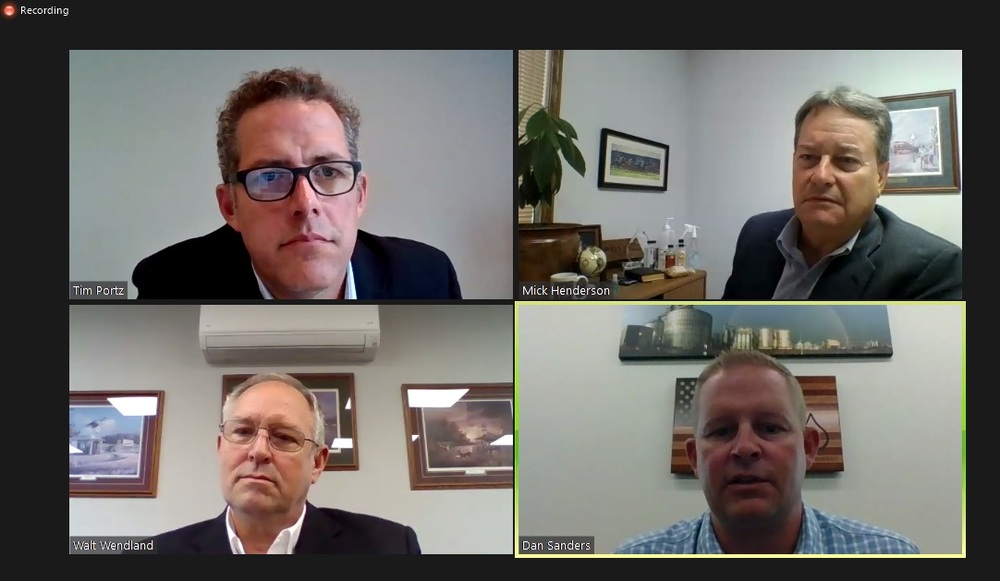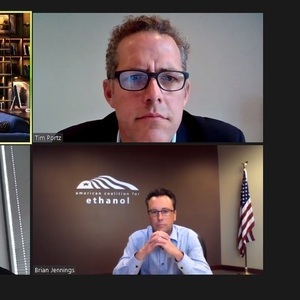FEW general sessions address policy, production



September 16, 2020
BY Lisa Gibson
Brian Jennings, CEO of the American Coalition for Ethanol, told audience members at the 2020 Fuel Ethanol Workshop & Expo during the general session panel Sept. 16 that the gap waiver denial, two days before, is a win, but there’s more work to do. Take a moment to rejoice, he said, but, “We’ve got to get right back to work.”
The 2020 FEW was, for the first time, held as a virtual event. General session panelists dialed in live Sept. 16 for a robust discussion. Chris Bliley, senior vice president of regulatory affairs for Growth Energy; Robert White, vice president of industry relations for the Renewable Fuels Association; and Jennings discussed the biggest industry issues with Tim Portz, program developer for BBI International.
The discussion, of course, focused intensely on small refinery waivers and the U.S. EPA’s tendency to grant breaks to refiners seeking to cut biofuels out of the market.
The denial of the gap year waivers boosted RIN prices slightly, to about 50 cents. It’s a good price for a normal marketplace, Jennings said. “But we’re not in a normal marketplace.”
Jennings also pointed out that the biggest win ethanol has seen was the U.S. Tenth Circuit Court of Appeals decision earlier this year. “Having EPA deny 54 of these gap year requests is not a gigantic win. The victory was the court case back in January.” The 10th Circuit found that the U.S. EPA went above its authority in granting certain small refinery exemptions.
EPS still has not applied that Tenth Circuit decision nationwide, Jennings added. “So, we’ve got an enormous amount of work to do with EPA.”
Discussion also touched on the pandemic and the derecho that whipped through Iowa in August. Bliley said Growth Energy’s members are still recovering and dealing with the effects of that disaster. Jennings and White agreed, and White said the industry is still in dire times. It has to continue to push on the politicly side and in the marketplace. As far as the pandemic, the industry is not looking to be back at full steam this year or even next year, White said.
The panel addressed the political climate and the presidential candidates. White said neither is a rubber stamp for ethanol, but it’s interesting ethanol has taken a position in the election as a talking point.
Advertisement
Advertisement
On production
Three of Ethanol Producer Magazine’s editorial board members followed up the policy panel and kicked off discussion by talking about their experiences with COVID-19. Mick Henderson, general manager of Commonwealth AgriEnergy in Hopkinsville, Kentucky, said the plant implemented temperature checks and how to deal with infections. As a small employer, it was a bit nerve-racking, as more than one employee out sick could mean the plant can’t run. “The worry was you could lose your business. Shoot, we didn’t know if those that got infected would lose their life. So, scary time to start.”
Walt Wendland, president and CEO of Ringneck Energy in Onida, South Dakota, said once March and April passed, the plant’s feet were back underneath it and had a semblance of normal in the industry. He called COVID a “cliff that we fell off.”
“We made sure that shifts didn’t interact with each other,” Wendland said. “We were cross training maintenance and grain people to be in operations if they needed to be. And we virtually locked the doors on our admin building.” Vendors are being careful and are back on-site with precautions, he added.
“So, we’ve returned to normal somewhat. But we feel that we’ve come through this pretty well.”
Dan Sanders, vice president of Front Range Energy in Windsor, Colorado, talked about being a bit closer to urban areas, and early spikes. Initially, of course, the concern was for human health, and, secondarily, the business model. “We were quick to get engaged on new protocols at the plant to deal with new safety and sanitization requirements.” Then Front Range started balancing markets.
Changes to the industry are for the better in handling infectious disease at plants, Henderson said.
“We’ll handle infectious disease much better than we have in the past,” Wendland said. As a new producer, Ringneck felt obligated to continue operating to maintain the relationship with suppliers, he added. “Being new, it was a total different experience.” Ringneck was able to downsize, but still meet its obligations.
Sanders agreed that the sanitization methods brought about during the pandemic will be long-lasting. “Even for a 13-year-old facility like ours, it was still eye-opening for us.”
Advertisement
Advertisement
As far as production levels, Sanders said plants are back to the “new normal.” It’ll take several years, he said, to even out demand and production. “Through 2021, I think we’ll continue to see a lower supply and demand balance, and we’ll see the industry adjust to that, as we’re seeing right now.”
The pandemic also has made plants look at diversifying, he added. It accelerated and broadened coproduct exploration across the industry. “I think it’s smart for the industry to have a more diversified business model.”
Henderson agreed and discussed Commonwealth’s pivot to hand sanitizer production in partnership with local bourbon producers. He said the plant will dabble in other streams, like protein, but other uses for ethanol are at the top of the list.
“I think it’s quite a feat that the industry was able to match demand,” Wendland said of hand sanitizer production. “I think it’s unprecedented for us to respond the way that we did.”
Ringneck also converted to hand sanitizer production during the pandemic for a few months, Wendland said. “I was amazed how fast the goal post moved. At first, they would take anything,” he said, referring to how guidance changed along the way. Sanders
There’s room in the industry for diversification chemically, enzymatically or mechanically, Sanders said. COVID-19 undoubtedly sped up the coproduct rush.
“If you were narrowed in on one particular coproduct, now you’re looking at four or five,” he said. “Plants that are able to deploy capital are going to put it to work.”
Related Stories
The Michigan Advanced Biofuels Coalition and Green Marine are partnering to accelerating adoption of sustainable biofuels to improve air quality and reduce GHG emissions in Michigan and across the Great Lakes and St. Lawrence Seaway.
The USDA reduced its outlook for 2024-’25 soybean oil use in biofuel production in its latest World Agricultural Supply and Demand Estimates report, released April 10. The outlook for soybean oil pricing was revised up.
Sen. Roger Marshall, R-Kan., and Rep. Marcy Kaptur, D-Iowa, on April 10 reintroduced legislation to extend the 45Z clean fuel production credit and limit eligibility for the credit to renewable fuels made from domestically sourced feedstocks.
Representatives of the U.S. biofuels industry on April 10 submitted comments to the U.S. Department of Treasury and IRFS providing recommendations on how to best implement upcoming 45Z clean fuel production credit regulations.
EIA reduces production forecasts for biobased diesel, increases forecast for other fuels, including SAF
The U.S. Energy Information Administration reduced its 2025 forecasts for renewable diesel and biodiesel in its latest Short-Term Energy Outlook, released April 10. The outlook for “other biofuel” production, which includes SAF, was raised.
Upcoming Events










